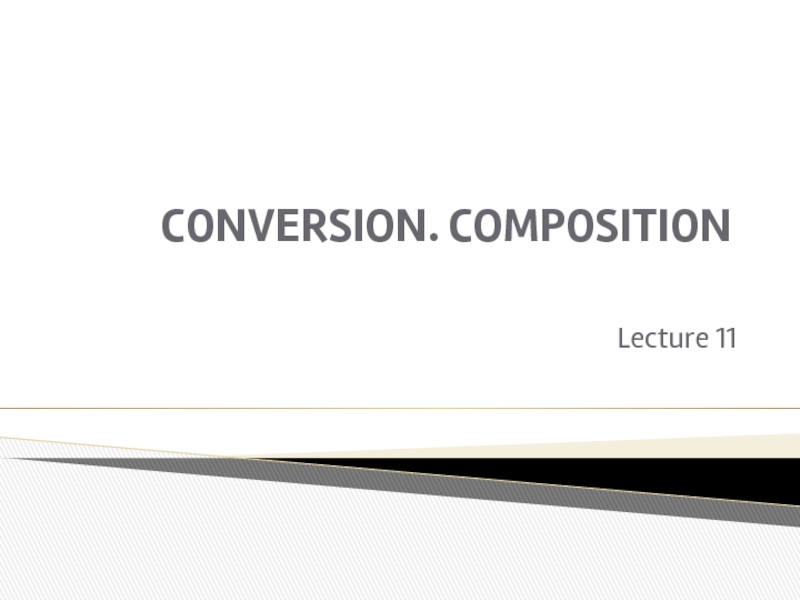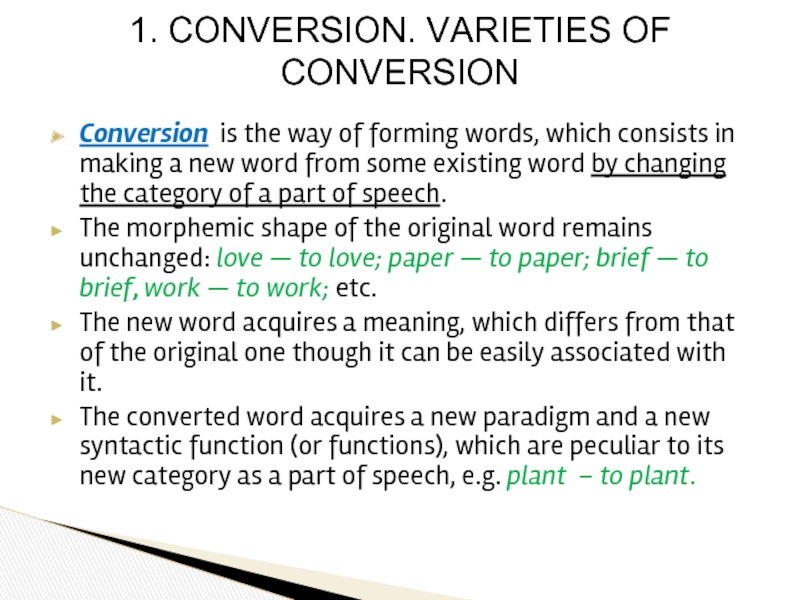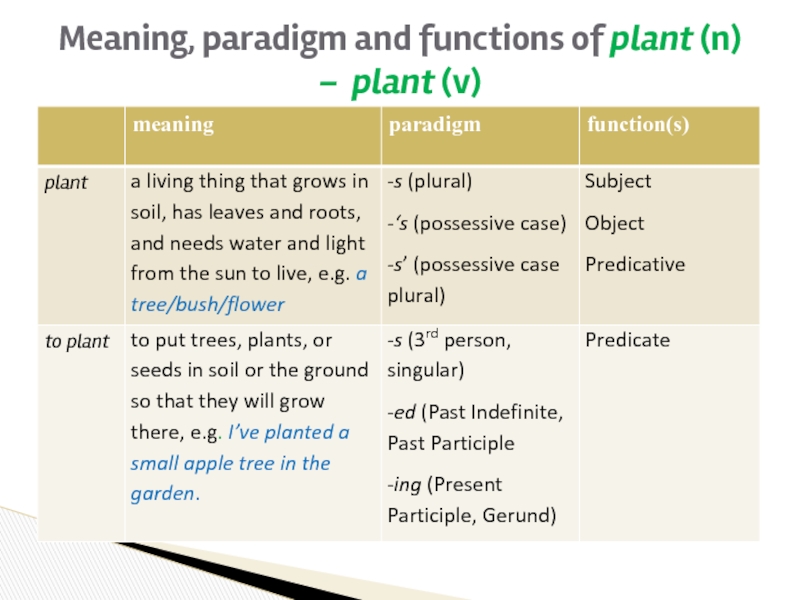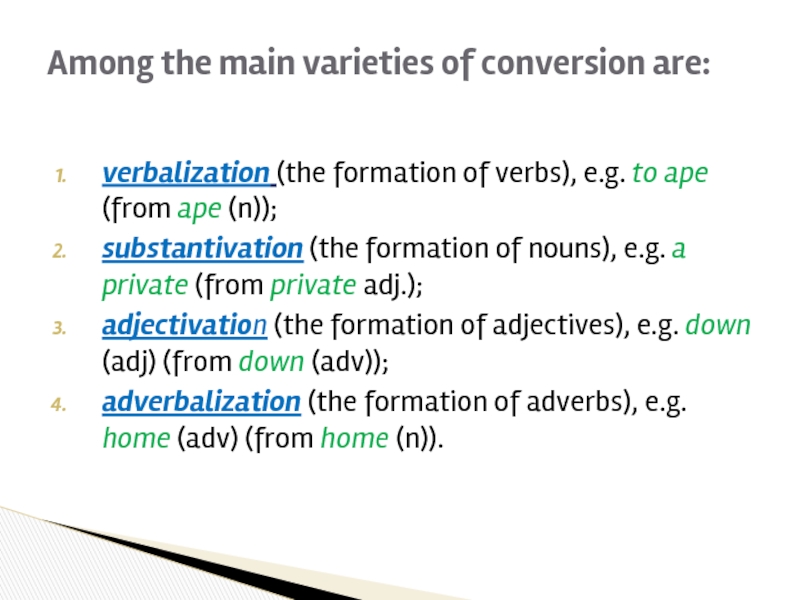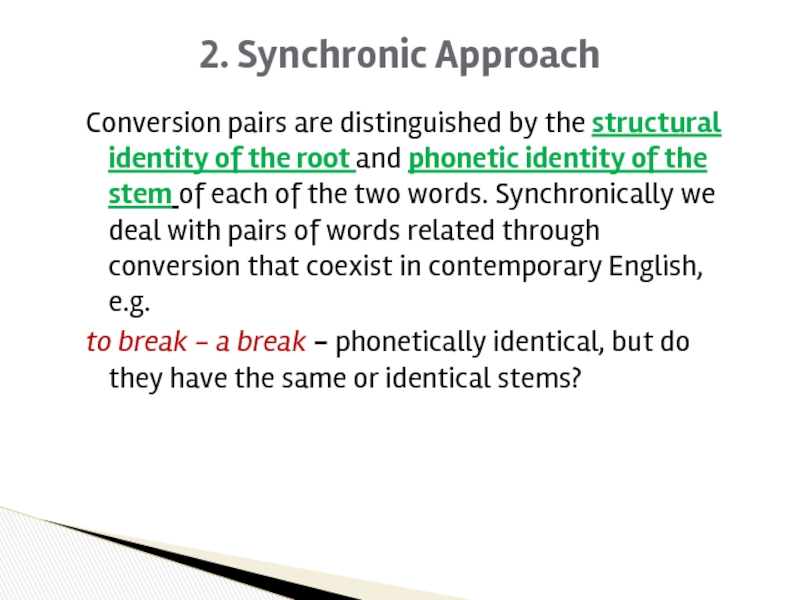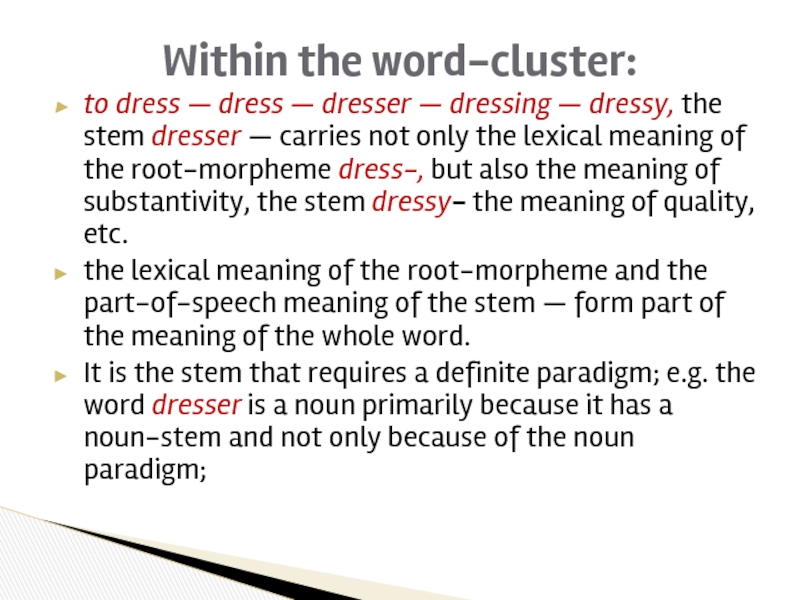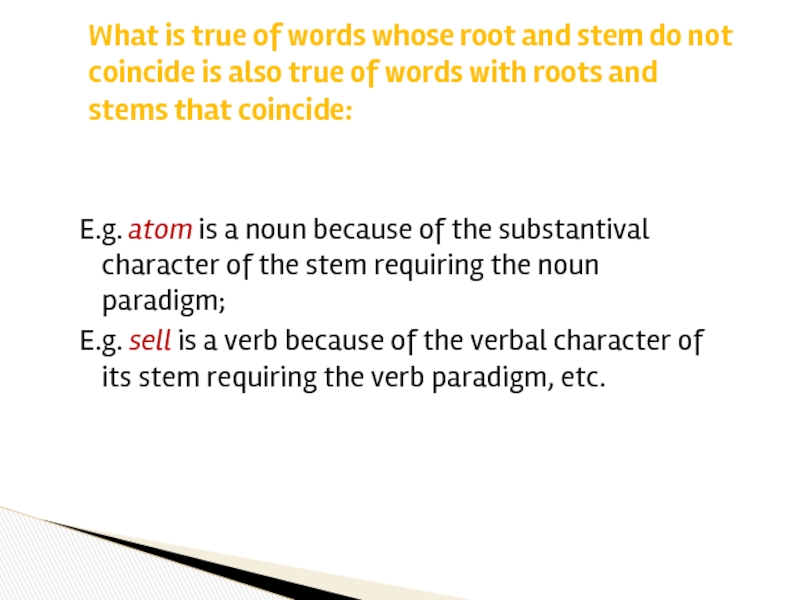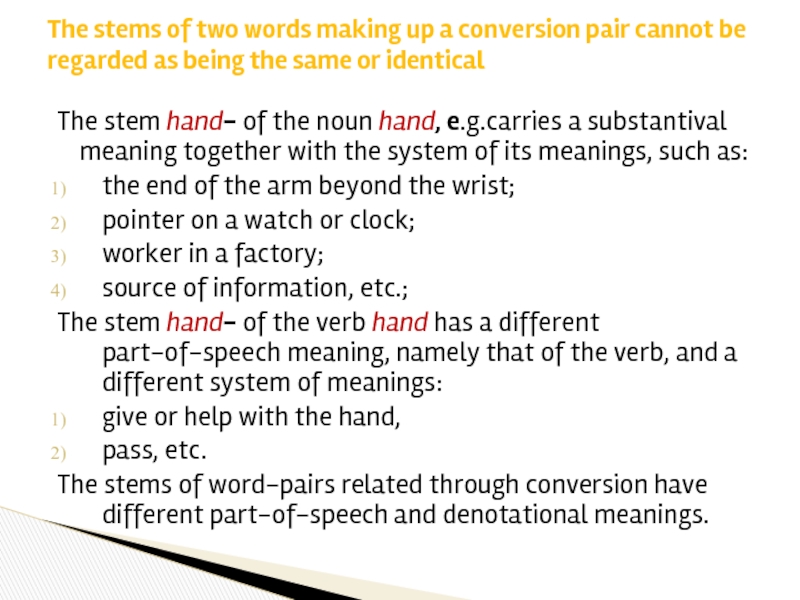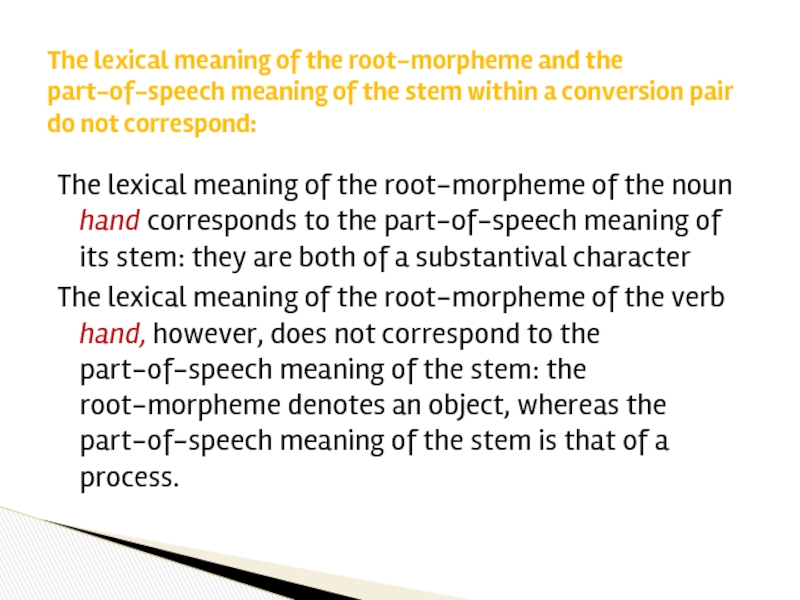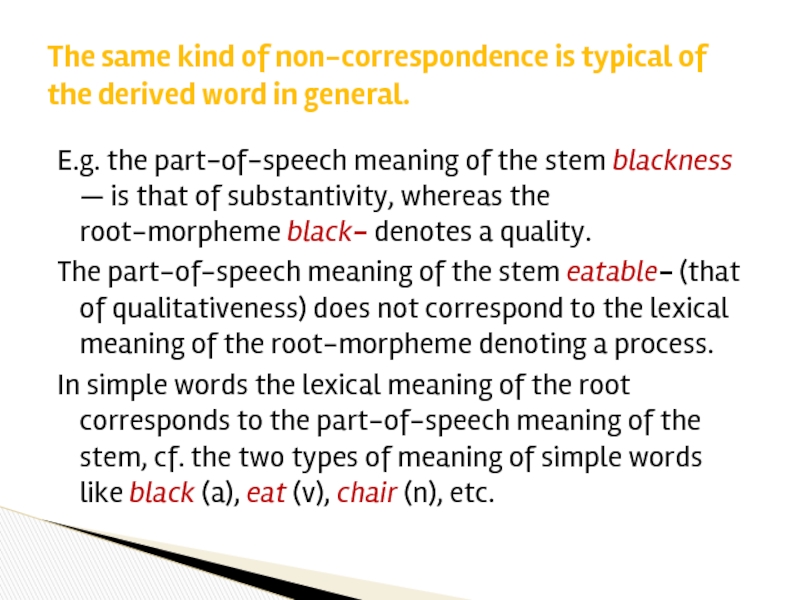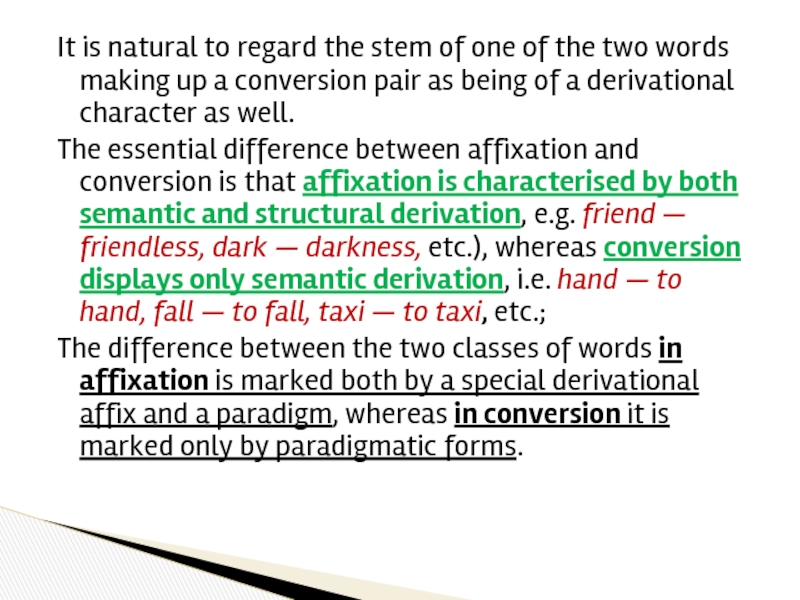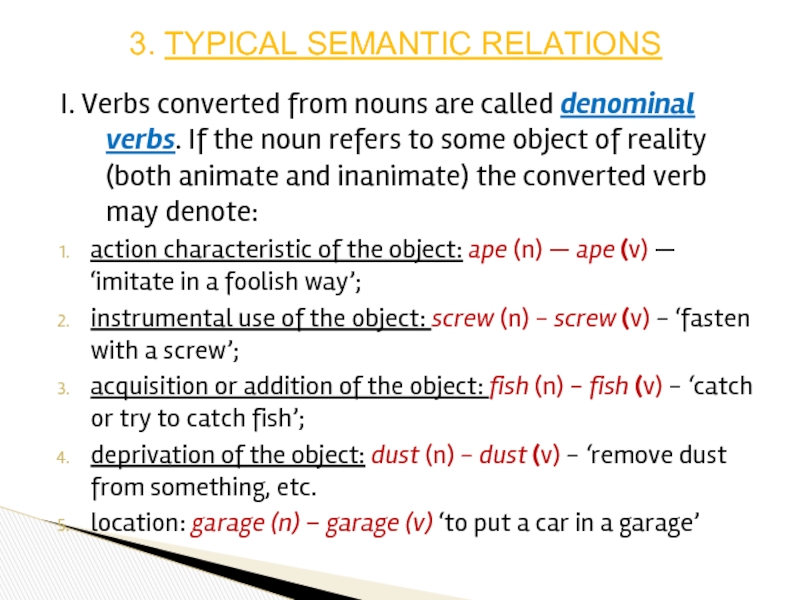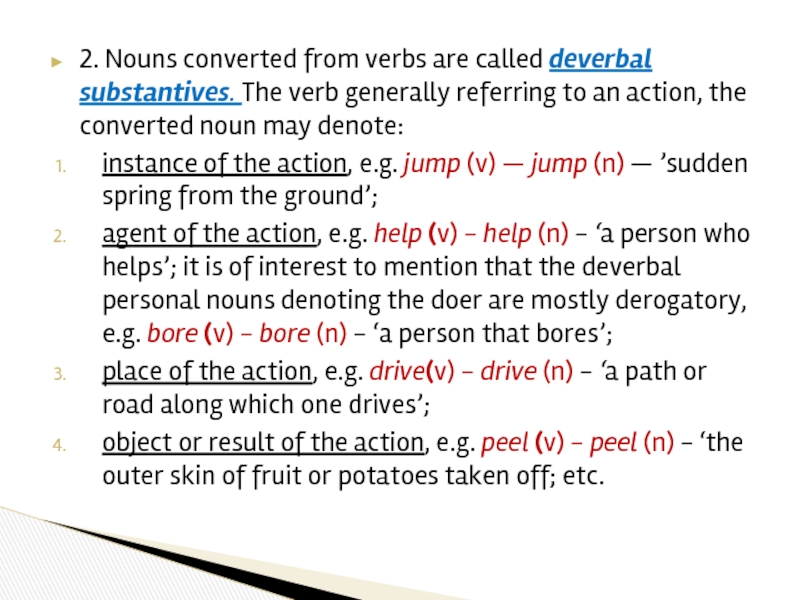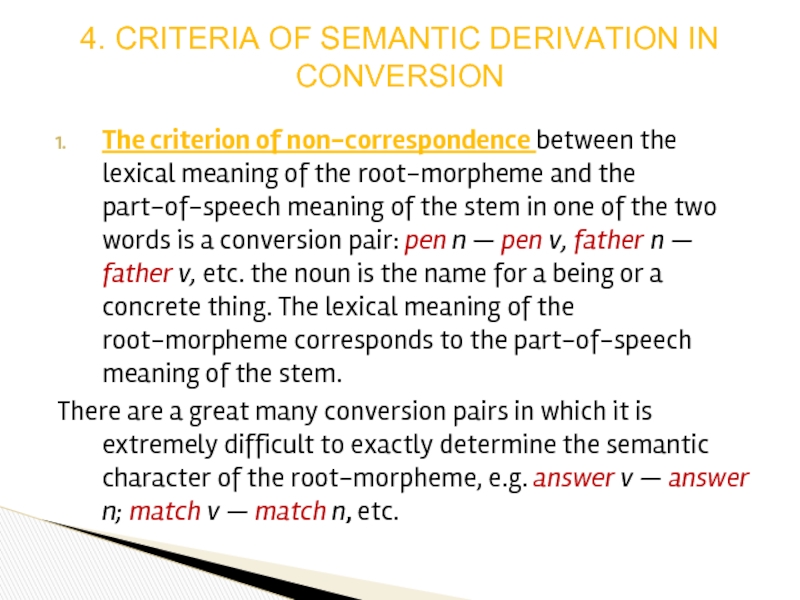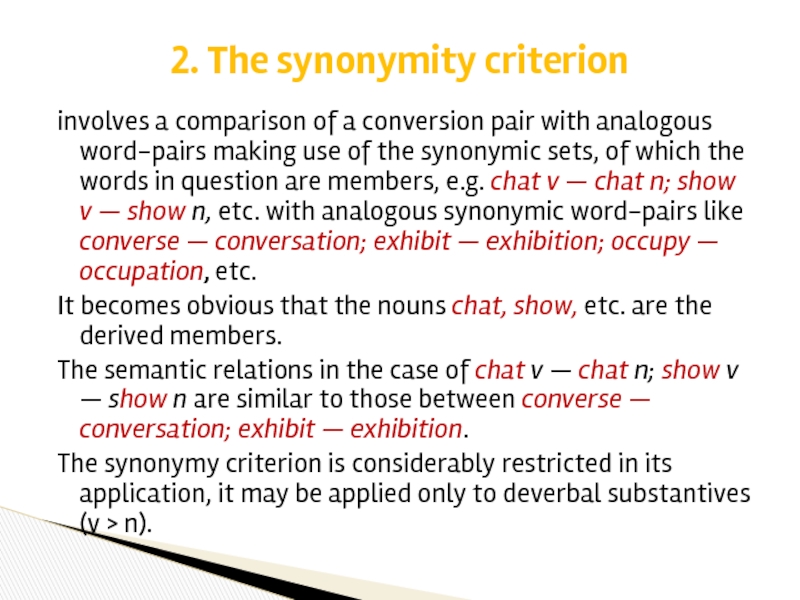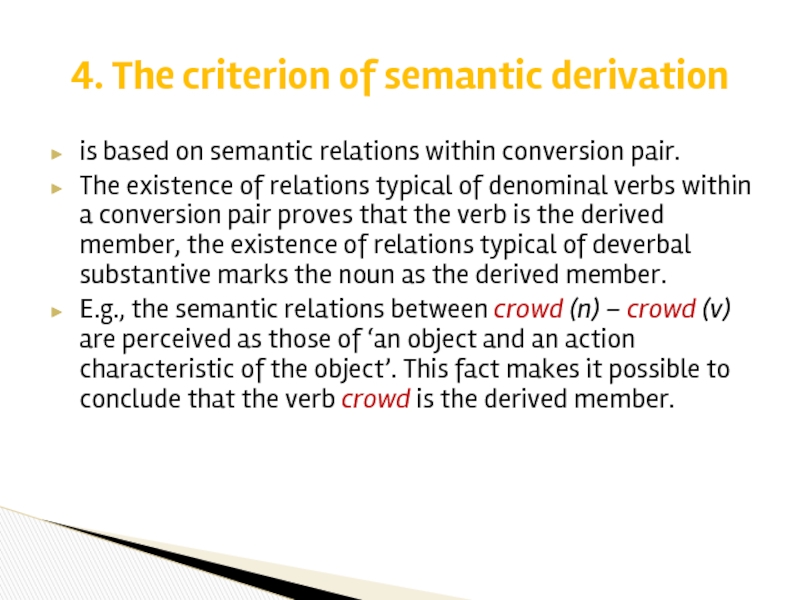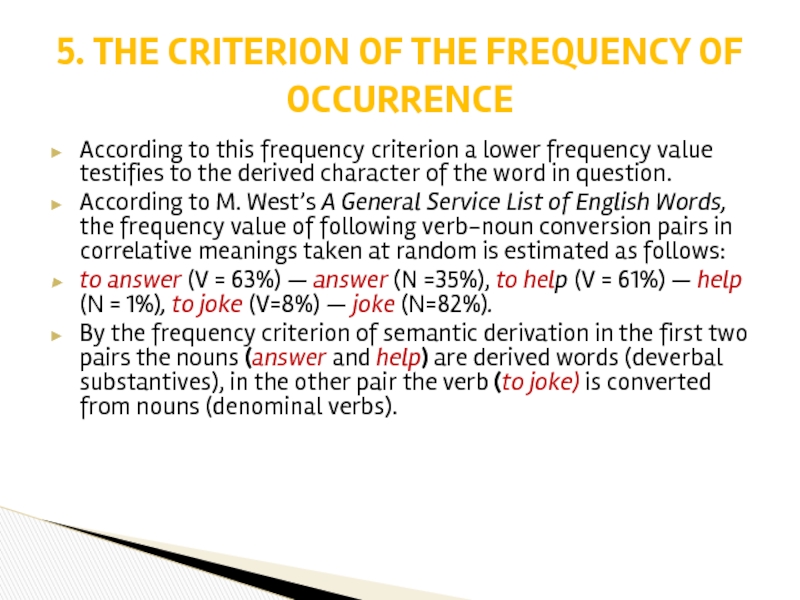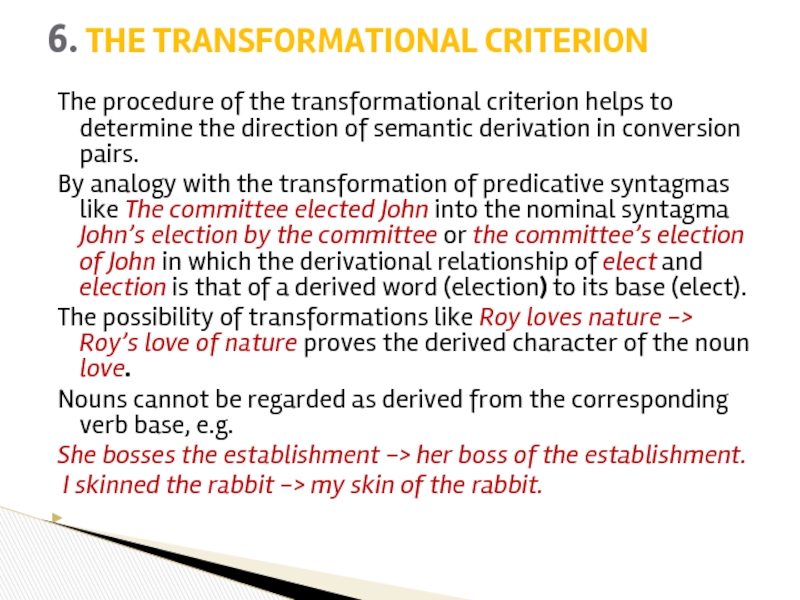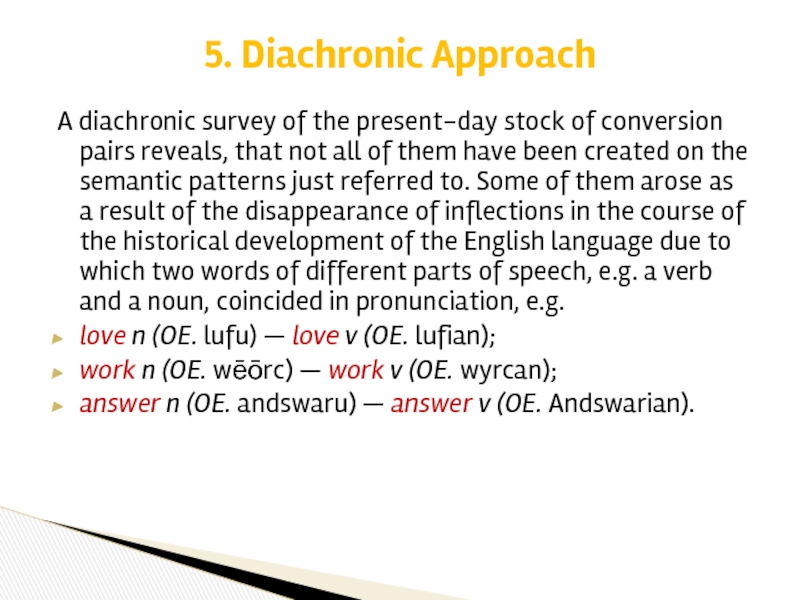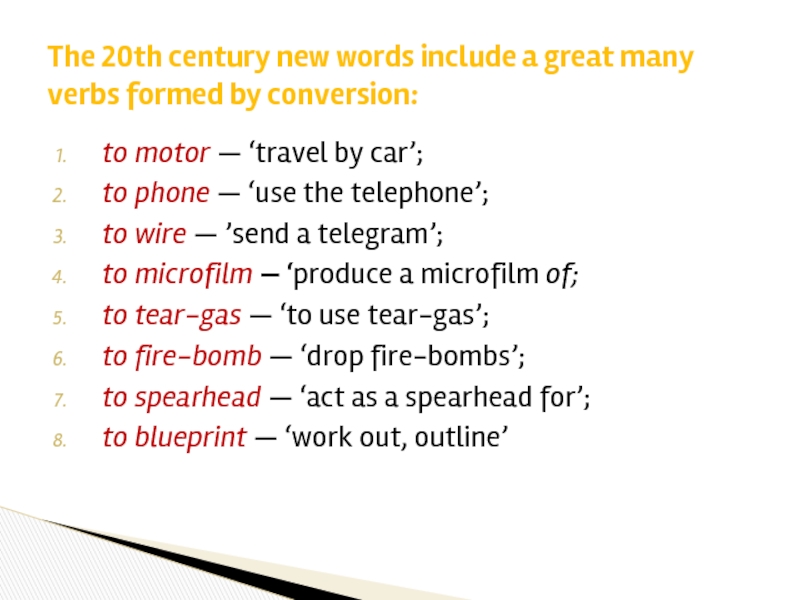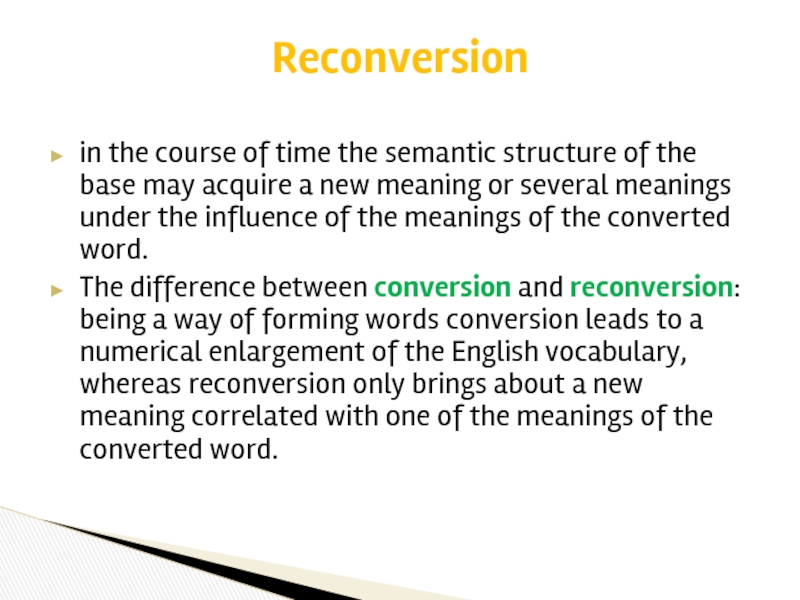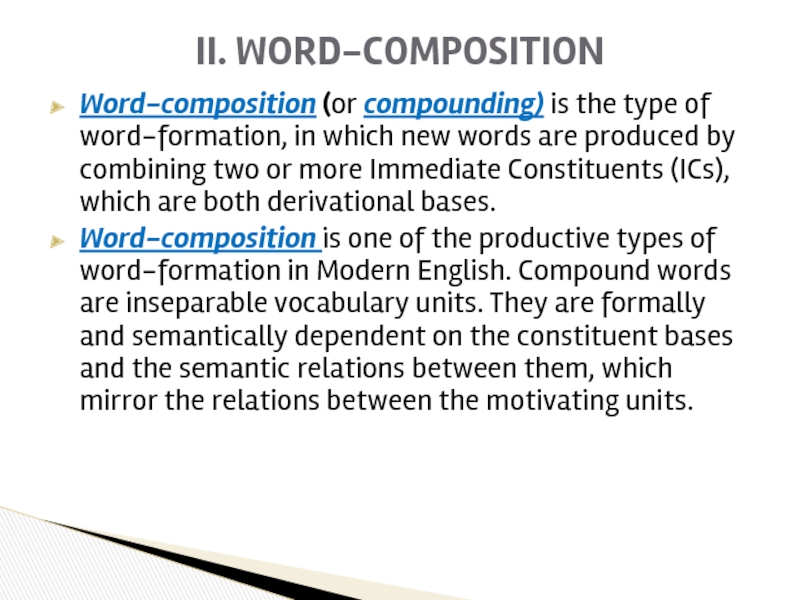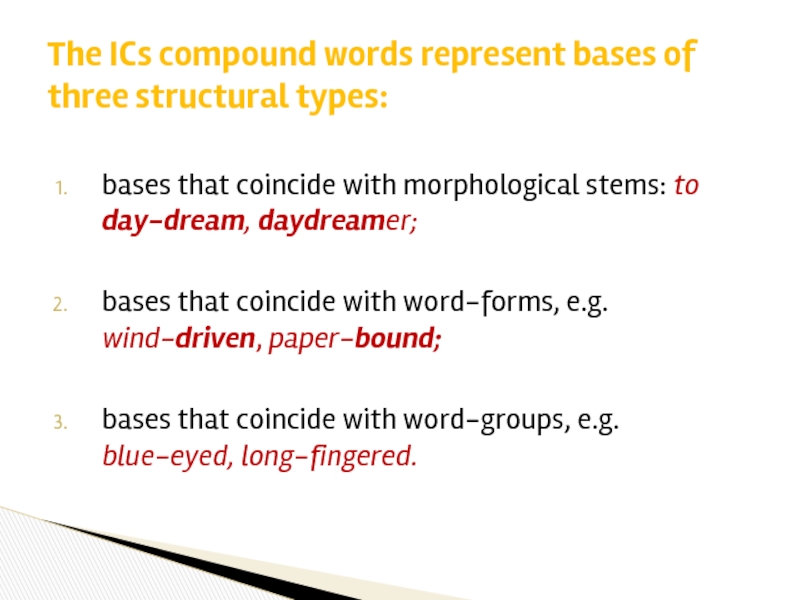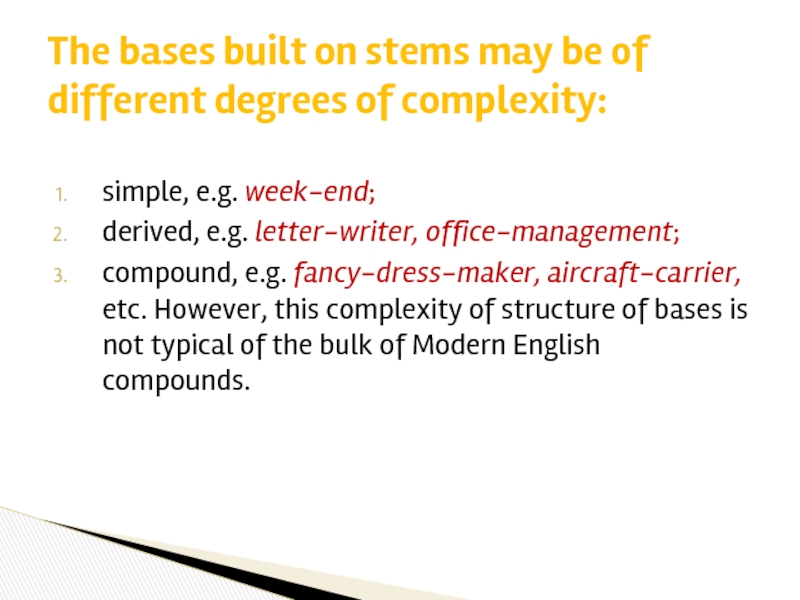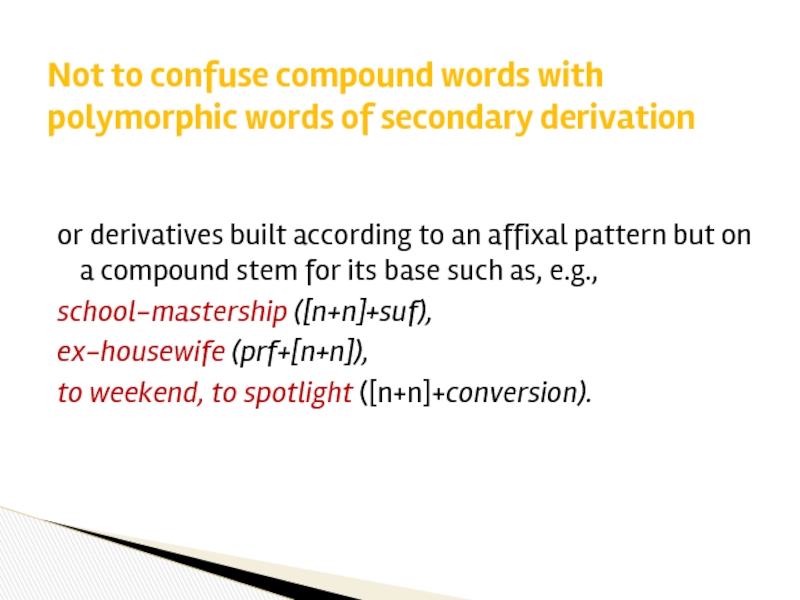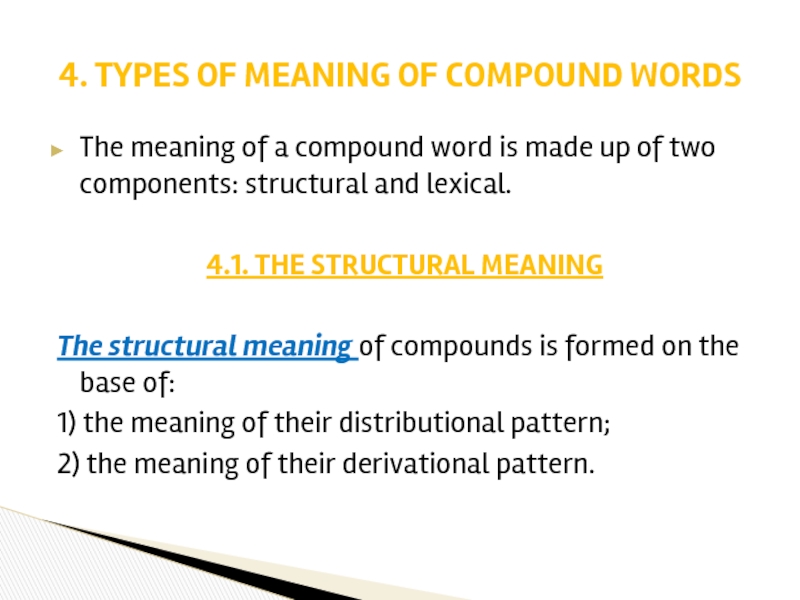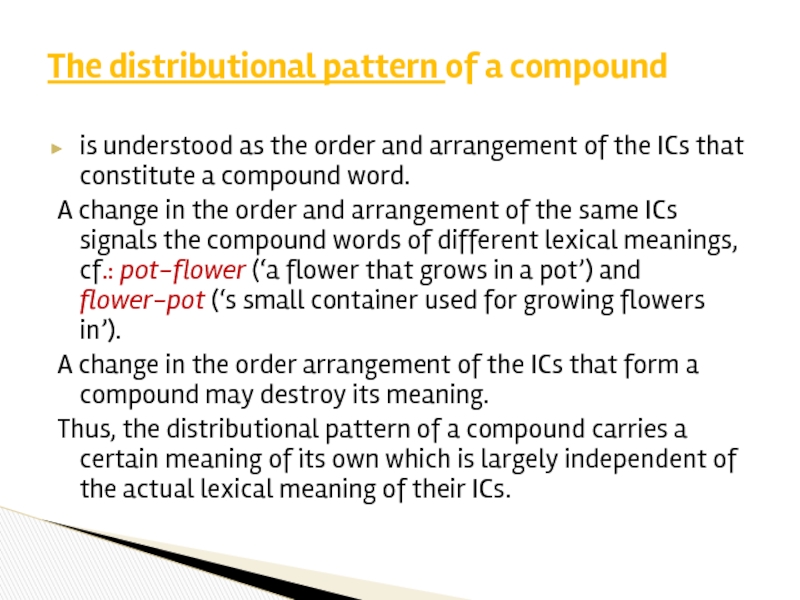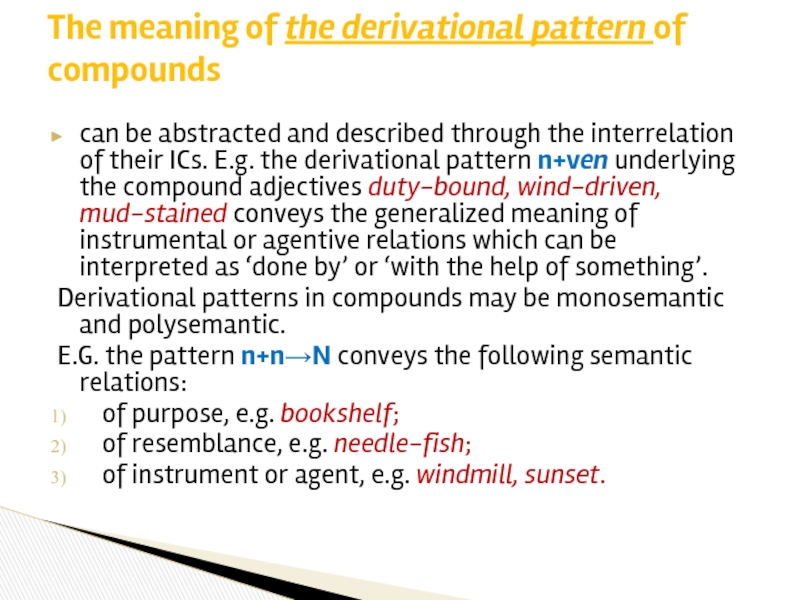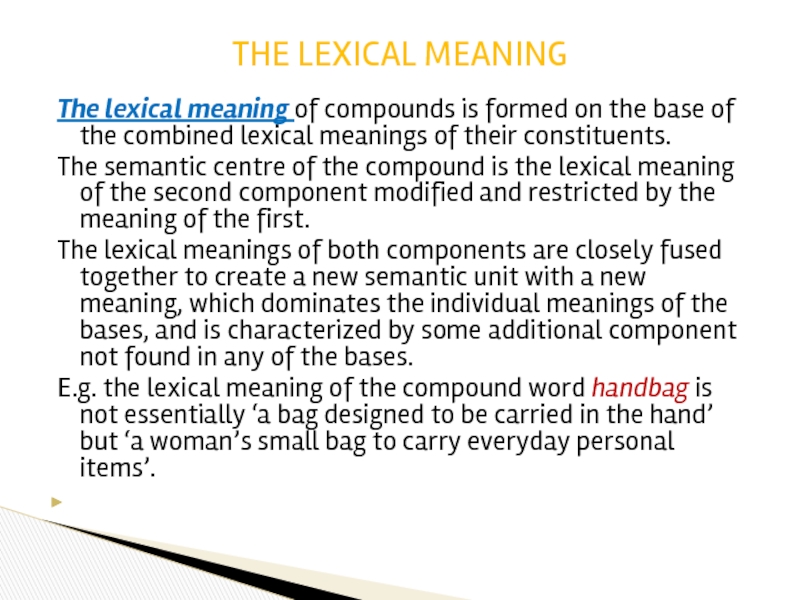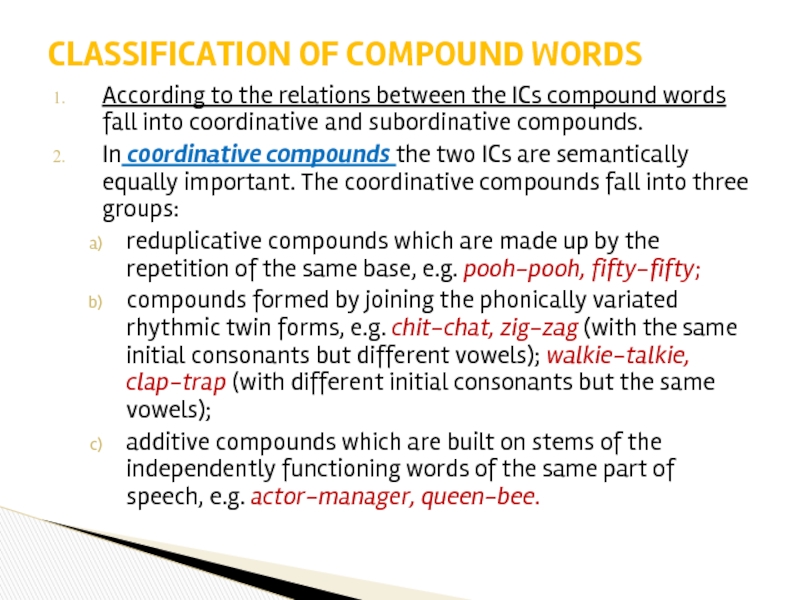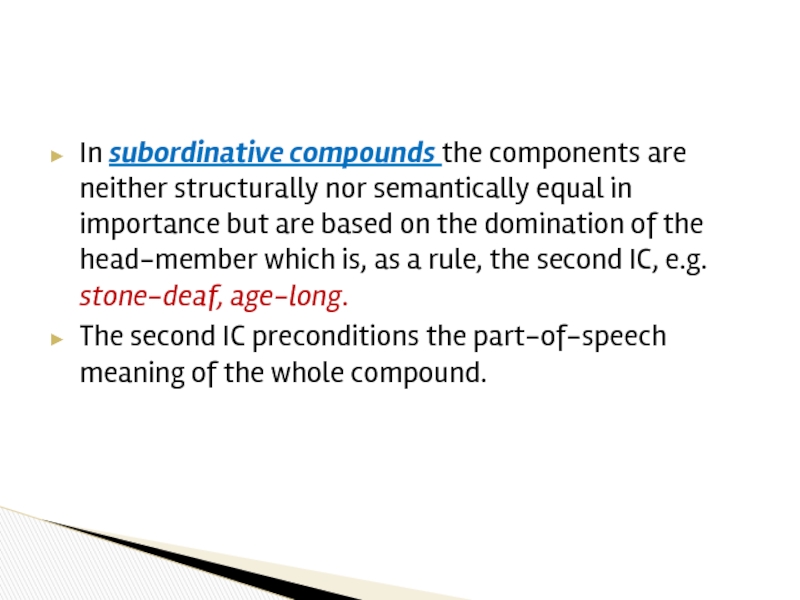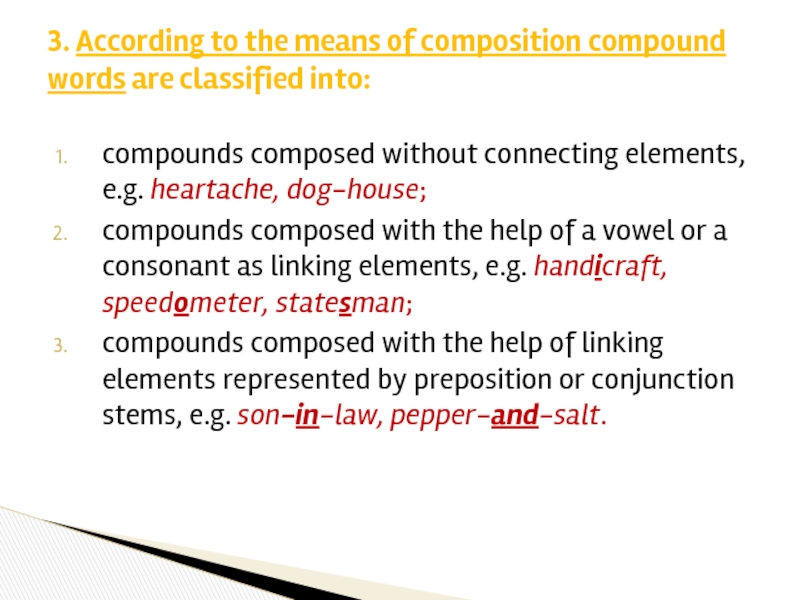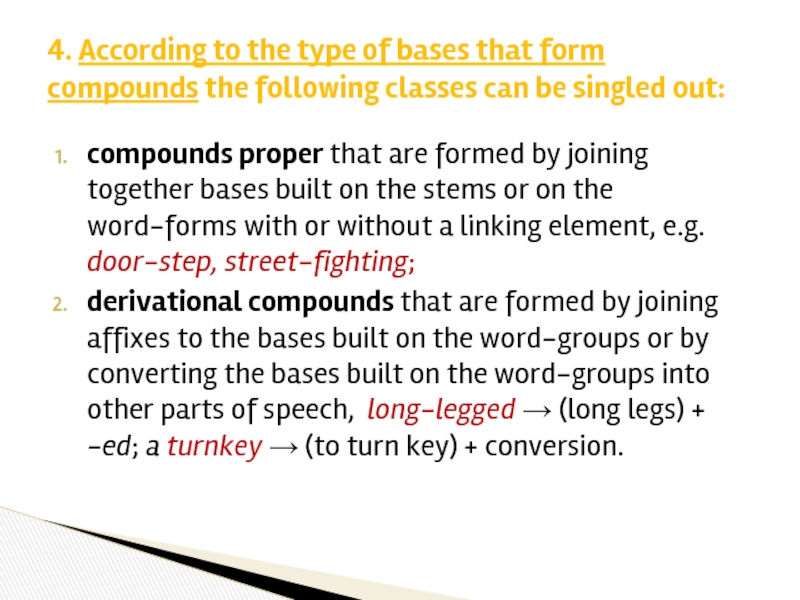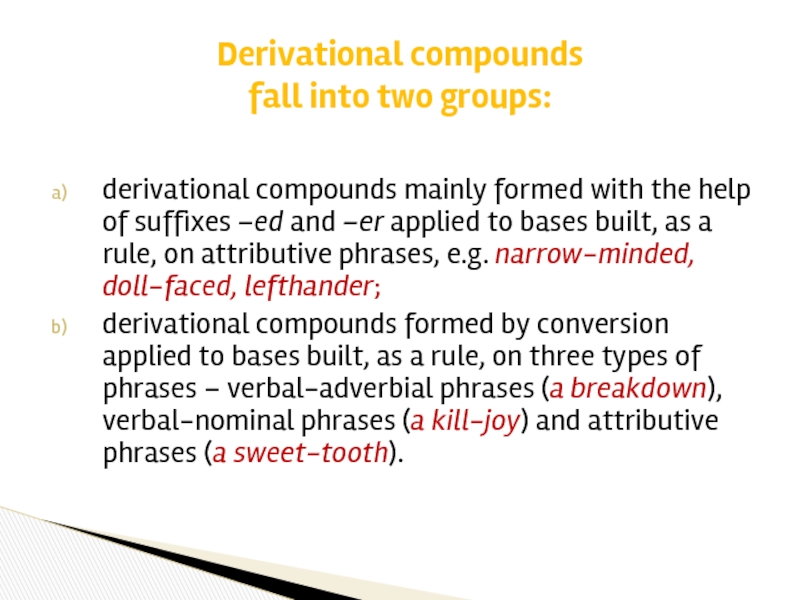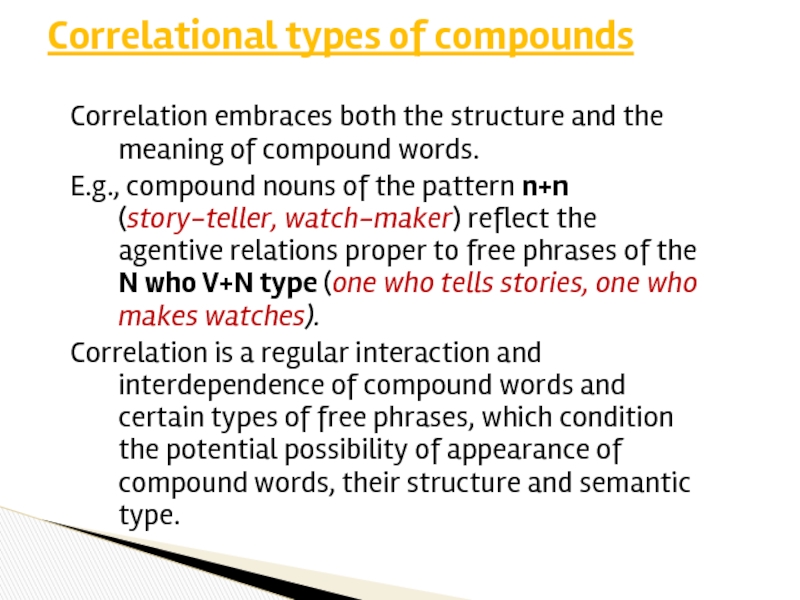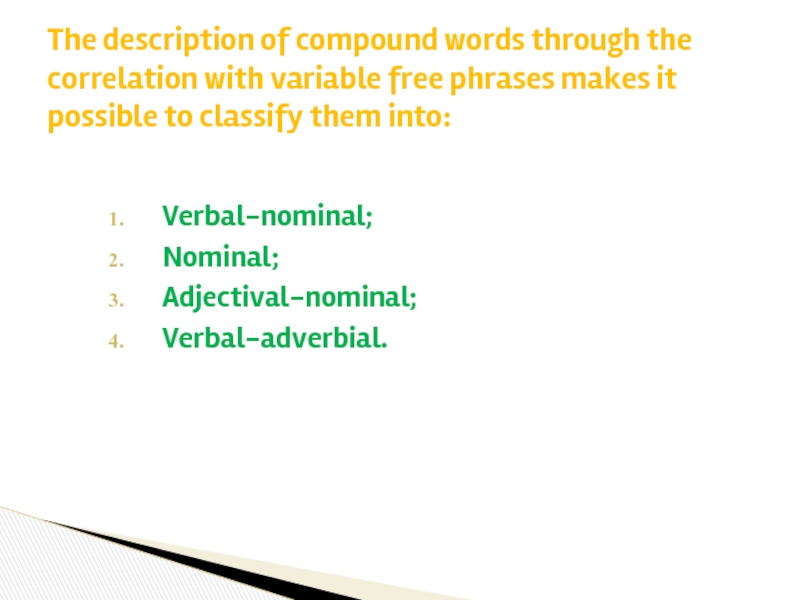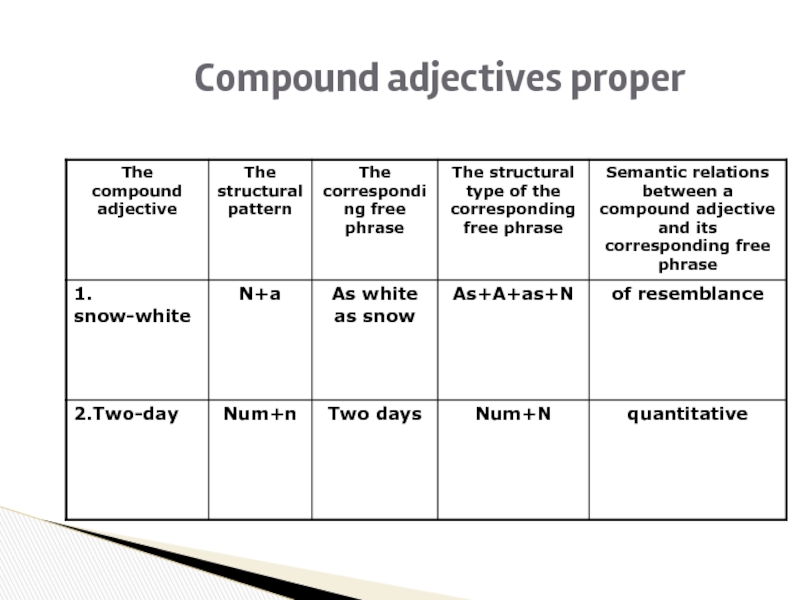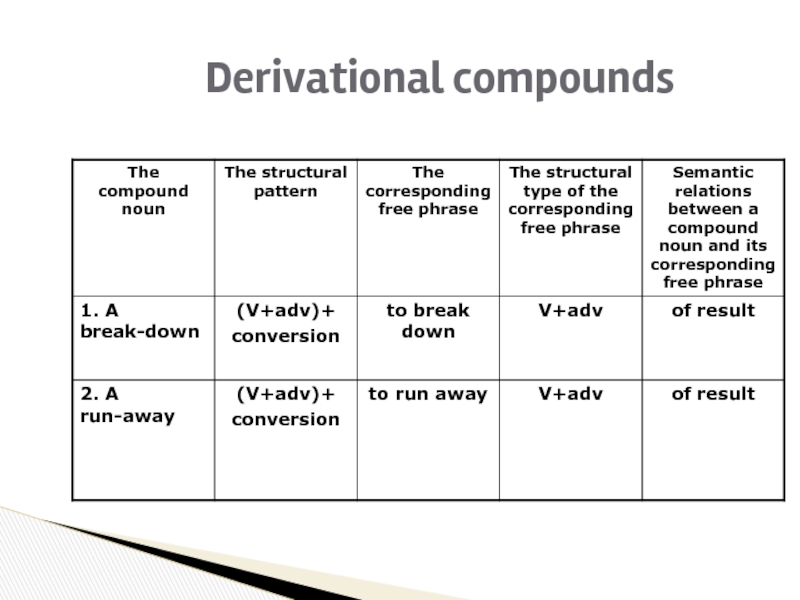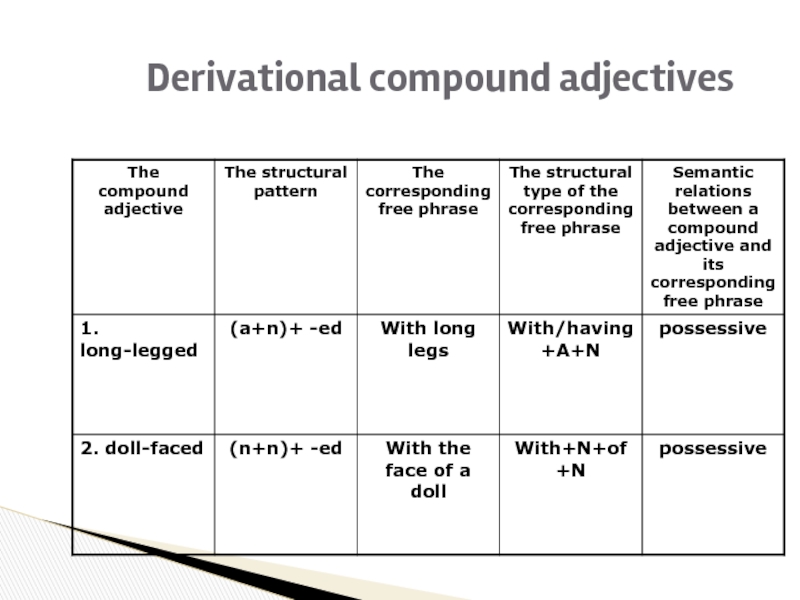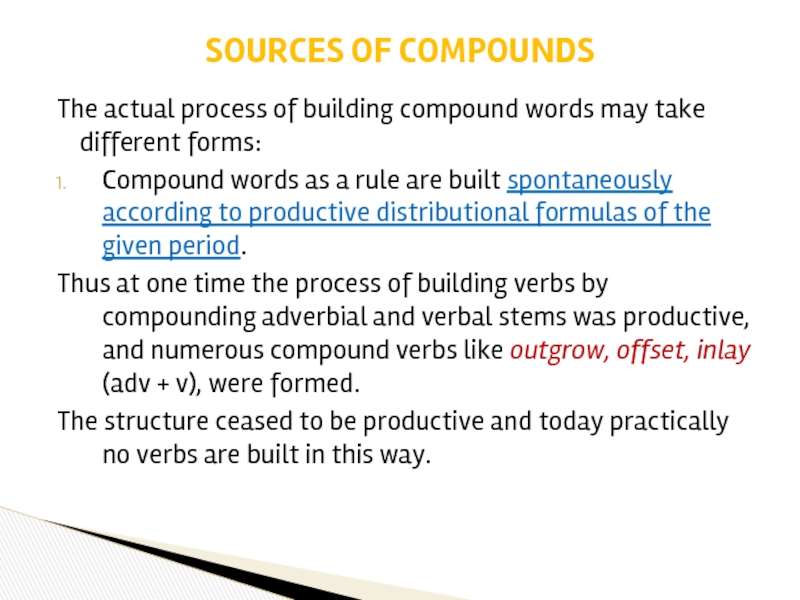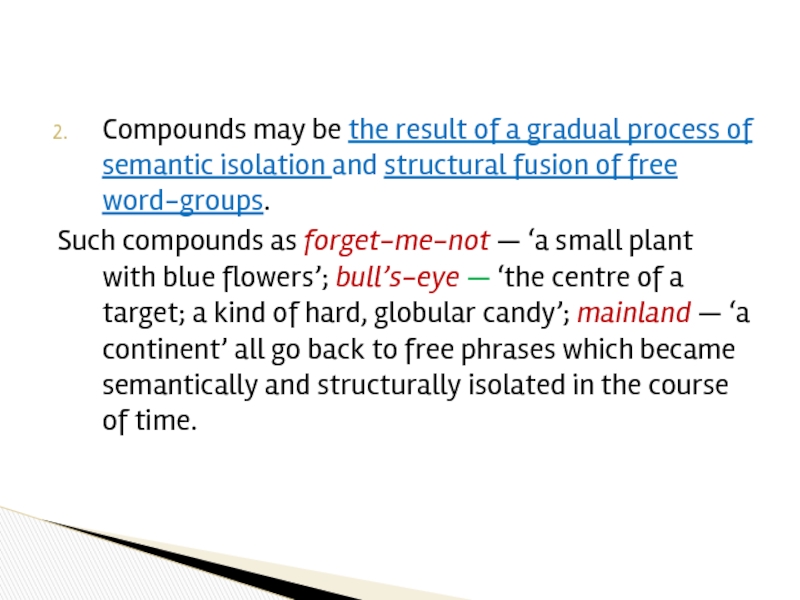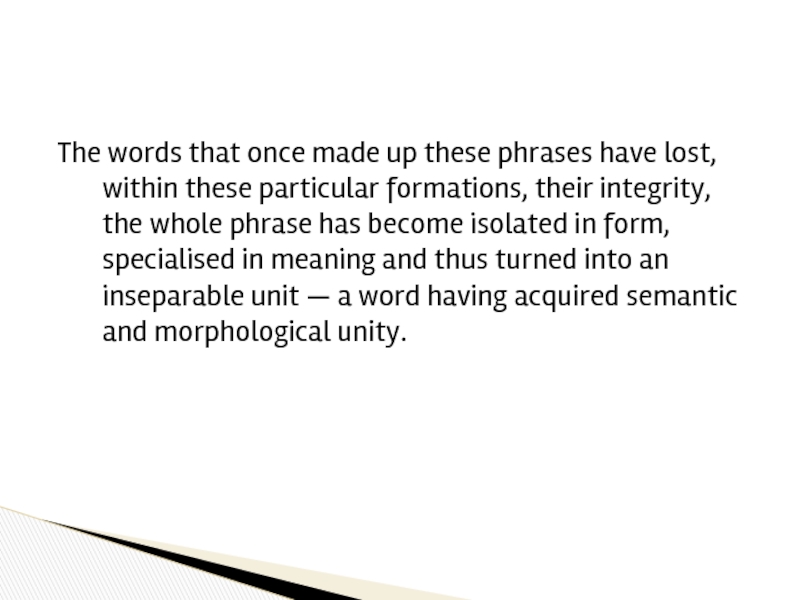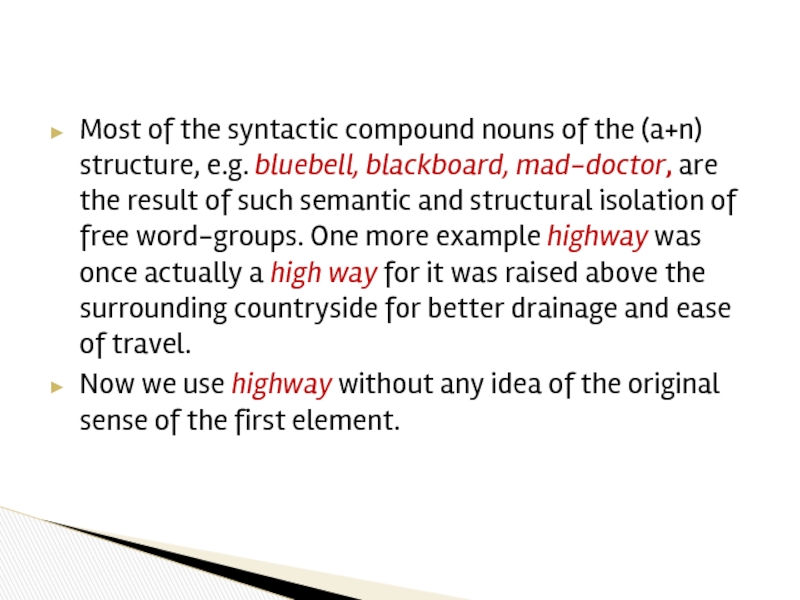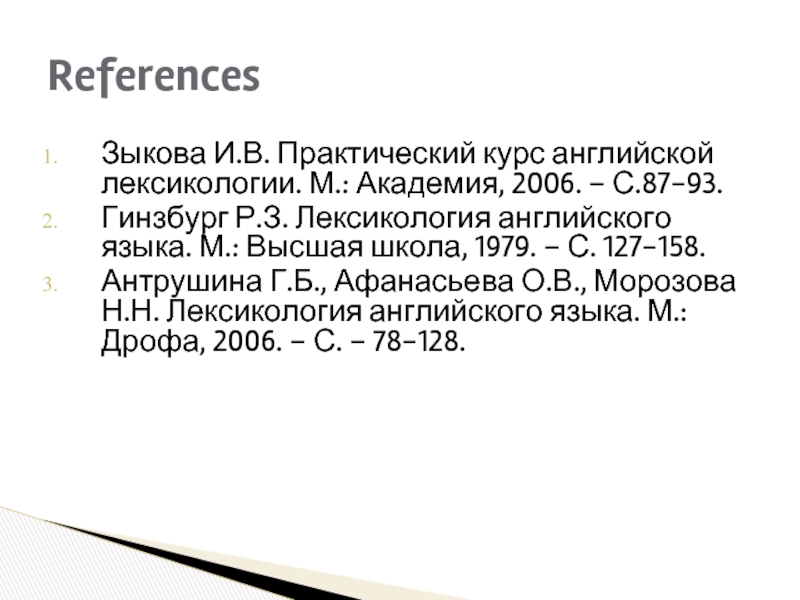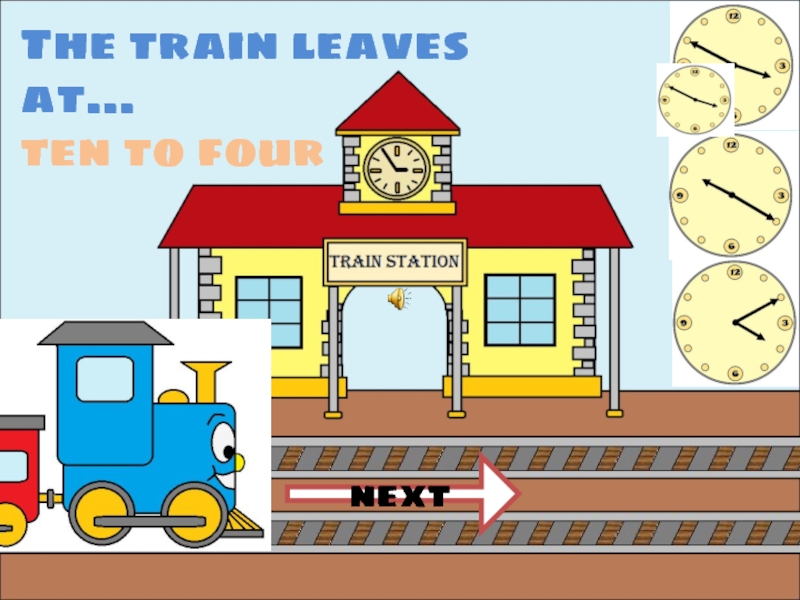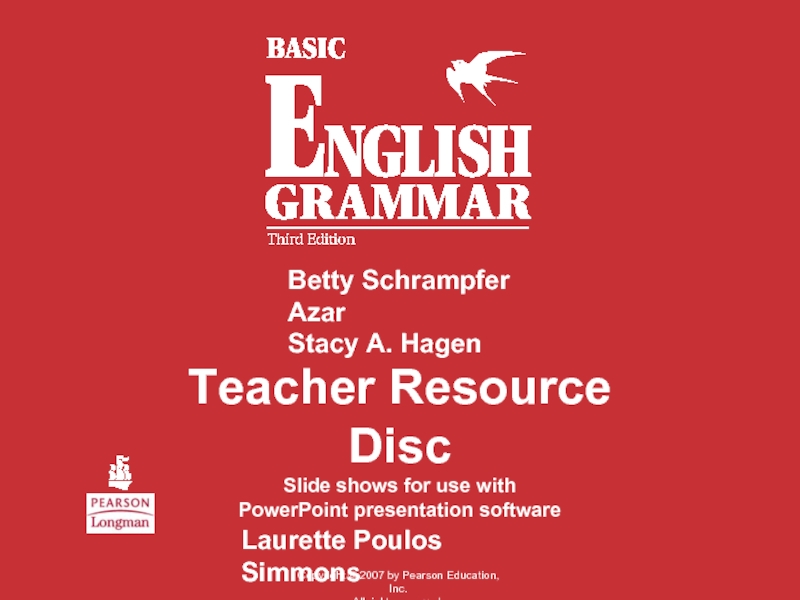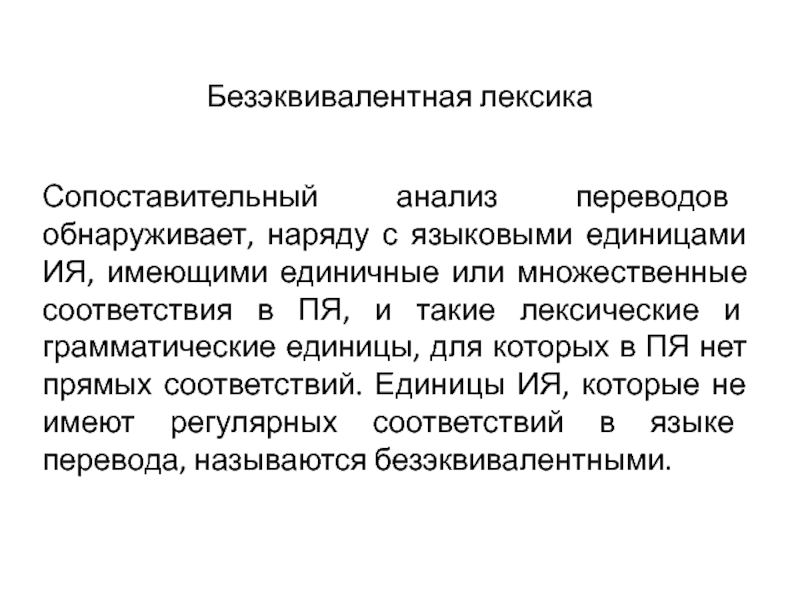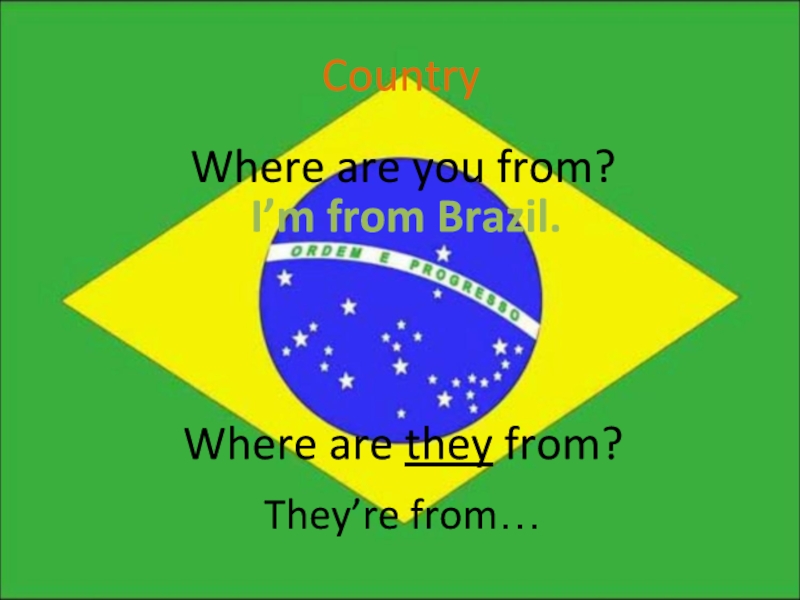- Главная
- Разное
- Дизайн
- Бизнес и предпринимательство
- Аналитика
- Образование
- Развлечения
- Красота и здоровье
- Финансы
- Государство
- Путешествия
- Спорт
- Недвижимость
- Армия
- Графика
- Культурология
- Еда и кулинария
- Лингвистика
- Английский язык
- Астрономия
- Алгебра
- Биология
- География
- Детские презентации
- Информатика
- История
- Литература
- Маркетинг
- Математика
- Медицина
- Менеджмент
- Музыка
- МХК
- Немецкий язык
- ОБЖ
- Обществознание
- Окружающий мир
- Педагогика
- Русский язык
- Технология
- Физика
- Философия
- Химия
- Шаблоны, картинки для презентаций
- Экология
- Экономика
- Юриспруденция
Conversion. Composition презентация
Содержание
- 1. Conversion. Composition
- 2. Conversion is the way of forming words,
- 3. Meaning, paradigm and functions of plant (n) – plant (v)
- 4. verbalization (the formation of verbs), e.g. to
- 5. Conversion pairs are distinguished by the structural
- 6. to dress — dress — dresser —
- 7. E.g. atom is a noun because of
- 8. The stem hand- of the noun hand,
- 9. The lexical meaning of the root-morpheme of
- 10. E.g. the part-of-speech meaning of the stem
- 11. It is natural to regard the stem
- 12. I. Verbs converted from nouns are called
- 13. 2. Nouns converted from verbs are called
- 14. The criterion of non-correspondence between the lexical
- 15. involves a comparison of a conversion pair
- 16. is based on derivational relations within the
- 17. is based on semantic relations within conversion
- 18. According to this frequency criterion a lower
- 19. The procedure of the transformational criterion helps
- 20. A diachronic survey of the present-day stock
- 21. to motor — ‘travel by car’;
- 22. in the course of time the semantic
- 23. The semantic structure of the base may
- 24. Word-composition (or compounding) is the type of
- 25. bases that coincide with morphological stems: to
- 26. simple, e.g. week-end; derived, e.g. letter-writer,
- 27. or derivatives built according to an affixal
- 28. The meaning of a compound word is
- 29. is understood as the order and arrangement
- 30. can be abstracted and described through the
- 31. The lexical meaning of compounds is formed
- 32. According to the relations between the ICs
- 33. In subordinative compounds the components are neither
- 34. compound nouns, e.g. sunbeam, maidservant; compound adjectives,
- 35. compounds composed without connecting elements, e.g. heartache,
- 36. compounds proper that are formed by joining
- 37. derivational compounds mainly formed with the
- 38. Correlational types of compounds Correlation embraces both
- 39. Verbal-nominal; Nominal; Adjectival-nominal; Verbal-adverbial. The description
- 40. Compound adjectives proper
- 41. Derivational compounds
- 42. Verbal-nominal compounds
- 43. Nominal compounds
- 44. Derivational compound adjectives
- 45. The actual process of building compound words
- 46. Compounds may be the result of a
- 47. The words that once made up these
- 48. Most of the syntactic compound nouns of
- 49. Зыкова И.В. Практический курс английской лексикологии. М.:
Слайд 2Conversion is the way of forming words, which consists in making
The morphemic shape of the original word remains unchanged: love — to love; paper — to paper; brief — to brief, work — to work; etc.
The new word acquires a meaning, which differs from that of the original one though it can be easily associated with it.
The converted word acquires a new paradigm and a new syntactic function (or functions), which are peculiar to its new category as a part of speech, e.g. plant – to plant.
1. CONVERSION. VARIETIES OF CONVERSION
Слайд 4verbalization (the formation of verbs), e.g. to ape (from ape (n));
substantivation
adjectivation (the formation of adjectives), e.g. down (adj) (from down (adv));
adverbalization (the formation of adverbs), e.g. home (adv) (from home (n)).
Among the main varieties of conversion are:
Слайд 5Conversion pairs are distinguished by the structural identity of the root
to break - a break - phonetically identical, but do they have the same or identical stems?
2. Synchronic Approach
Слайд 6to dress — dress — dresser — dressing — dressy, the
the lexical meaning of the root-morpheme and the part-of-speech meaning of the stem — form part of the meaning of the whole word.
It is the stem that requires a definite paradigm; e.g. the word dresser is a noun primarily because it has a noun-stem and not only because of the noun paradigm;
Within the word-cluster:
Слайд 7E.g. atom is a noun because of the substantival character of
E.g. sell is a verb because of the verbal character of its stem requiring the verb paradigm, etc.
What is true of words whose root and stem do not coincide is also true of words with roots and stems that coincide:
Слайд 8The stem hand- of the noun hand, e.g.carries a substantival meaning
the end of the arm beyond the wrist;
pointer on a watch or clock;
worker in a factory;
source of information, etc.;
The stem hand- of the verb hand has a different part-of-speech meaning, namely that of the verb, and a different system of meanings:
give or help with the hand,
pass, etc.
The stems of word-pairs related through conversion have different part-of-speech and denotational meanings.
The stems of two words making up a conversion pair cannot be regarded as being the same or identical
Слайд 9The lexical meaning of the root-morpheme of the noun hand corresponds
The lexical meaning of the root-morpheme of the verb hand, however, does not correspond to the part-of-speech meaning of the stem: the root-morpheme denotes an object, whereas the part-of-speech meaning of the stem is that of a process.
The lexical meaning of the root-morpheme and the part-of-speech meaning of the stem within a conversion pair do not correspond:
Слайд 10E.g. the part-of-speech meaning of the stem blackness — is that
The part-of-speech meaning of the stem eatable- (that of qualitativeness) does not correspond to the lexical meaning of the root-morpheme denoting a process.
In simple words the lexical meaning of the root corresponds to the part-of-speech meaning of the stem, cf. the two types of meaning of simple words like black (a), eat (v), chair (n), etc.
The same kind of non-correspondence is typical of the derived word in general.
Слайд 11It is natural to regard the stem of one of the
The essential difference between affixation and conversion is that affixation is characterised by both semantic and structural derivation, e.g. friend — friendless, dark — darkness, etc.), whereas conversion displays only semantic derivation, i.e. hand — to hand, fall — to fall, taxi — to taxi, etc.;
The difference between the two classes of words in affixation is marked both by a special derivational affix and a paradigm, whereas in conversion it is marked only by paradigmatic forms.
Слайд 12I. Verbs converted from nouns are called denominal verbs. If the
action characteristic of the object: ape (n) — ape (v) — ‘imitate in a foolish way’;
instrumental use of the object: screw (n) − screw (v) − ‘fasten with a screw’;
acquisition or addition of the object: fish (n) - fish (v) − ‘catch or try to catch fish’;
deprivation of the object: dust (n) − dust (v) − ‘remove dust from something, etc.
location: garage (n) – garage (v) ‘to put a car in a garage’
3. TYPICAL SEMANTIC RELATIONS
Слайд 132. Nouns converted from verbs are called deverbal substantives. The verb
instance of the action, e.g. jump (v) — jump (n) — ’sudden spring from the ground’;
agent of the action, e.g. help (v) − help (n) − ‘a person who helps’; it is of interest to mention that the deverbal personal nouns denoting the doer are mostly derogatory, e.g. bore (v) − bore (n) − ‘a person that bores’;
place of the action, e.g. drive(v) − drive (n) − ‘a path or road along which one drives’;
object or result of the action, e.g. peel (v) − peel (n) − ‘the outer skin of fruit or potatoes taken off; etc.
Слайд 14The criterion of non-correspondence between the lexical meaning of the root-morpheme
There are a great many conversion pairs in which it is extremely difficult to exactly determine the semantic character of the root-morpheme, e.g. answer v — answer n; match v — match n, etc.
4. CRITERIA OF SEMANTIC DERIVATION IN CONVERSION
Слайд 15involves a comparison of a conversion pair with analogous word-pairs making
It becomes obvious that the nouns chat, show, etc. are the derived members.
The semantic relations in the case of chat v — chat n; show v — show n are similar to those between converse — conversation; exhibit — exhibition.
The synonymy criterion is considerably restricted in its application, it may be applied only to deverbal substantives (v > n).
2. The synonymity criterion
Слайд 16is based on derivational relations within the word-cluster of which the
If the centre of the cluster is a verb, all derived words of the first degree of derivation have suffixes generally added to a verb-base. The centre of a cluster being a noun, all the first-degree derivatives have suffixes generally added to a noun-base.
In the word-cluster hand n — hand v — handful — handy — handed the derived words have suffixes added to the noun-base which makes it possible to conclude that the structural and semantic centre of the whole cluster is the noun hand.
Consequently, the verb hand is semantically derived from the noun hand.
3. THE CRITERION OF DERIVATIONAL RELATIONS
Слайд 17is based on semantic relations within conversion pair.
The existence of
E.g., the semantic relations between crowd (n) – crowd (v) are perceived as those of ‘an object and an action characteristic of the object’. This fact makes it possible to conclude that the verb crowd is the derived member.
4. The criterion of semantic derivation
Слайд 18According to this frequency criterion a lower frequency value testifies to
According to M. West’s A General Service List of English Words, the frequency value of following verb-noun conversion pairs in correlative meanings taken at random is estimated as follows:
to answer (V = 63%) — answer (N =35%), to help (V = 61%) — help (N = 1%), to joke (V=8%) — joke (N=82%).
By the frequency criterion of semantic derivation in the first two pairs the nouns (answer and help) are derived words (deverbal substantives), in the other pair the verb (to joke) is converted from nouns (denominal verbs).
5. THE CRITERION OF THE FREQUENCY OF OCCURRENCE
Слайд 19The procedure of the transformational criterion helps to determine the direction
By analogy with the transformation of predicative syntagmas like The committee elected John into the nominal syntagma John’s election by the committee or the committee’s election of John in which the derivational relationship of elect and election is that of a derived word (election) to its base (elect).
The possibility of transformations like Roy loves nature -> Roy’s love of nature proves the derived character of the noun love.
Nouns cannot be regarded as derived from the corresponding verb base, e.g.
She bosses the establishment -> her boss of the establishment.
I skinned the rabbit -> my skin of the rabbit.
6. THE TRANSFORMATIONAL CRITERION
Слайд 20A diachronic survey of the present-day stock of conversion pairs reveals,
love n (OE. lufu) — love v (OE. lufian);
work n (OE. wēōrc) — work v (OE. wyrcan);
answer n (OE. andswaru) — answer v (OE. Andswarian).
5. Diachronic Approach
Слайд 21to motor — ‘travel by car’;
to phone — ‘use the
to wire — ’send a telegram’;
to microfilm — ‘produce a microfilm of;
to tear-gas — ‘to use tear-gas’;
to fire-bomb — ‘drop fire-bombs’;
to spearhead — ‘act as a spearhead for’;
to blueprint — ‘work out, outline’
The 20th century new words include a great many verbs formed by conversion:
Слайд 22in the course of time the semantic structure of the base
The difference between conversion and reconversion: being a way of forming words conversion leads to a numerical enlargement of the English vocabulary, whereas reconversion only brings about a new meaning correlated with one of the meanings of the converted word.
Reconversion
Слайд 23The semantic structure of the base may acquire a new meaning
The verb smoke formed in 1000 from the noun smoke in the corresponding meaning had acquired by 1663 another meaning by a metaphorical transfer which, in turn, gave rise to a correlative meaning of the noun smoke in 1715 through reconversion.
Reconversion
Слайд 24Word-composition (or compounding) is the type of word-formation, in which new
Word-composition is one of the productive types of word-formation in Modern English. Compound words are inseparable vocabulary units. They are formally and semantically dependent on the constituent bases and the semantic relations between them, which mirror the relations between the motivating units.
II. WORD-COMPOSITION
Слайд 25bases that coincide with morphological stems: to day-dream, daydreamer;
bases that coincide
bases that coincide with word-groups, e.g. blue-eyed, long-fingered.
The ICs compound words represent bases of three structural types:
Слайд 26simple, e.g. week-end;
derived, e.g. letter-writer, office-management;
compound, e.g. fancy-dress-maker, aircraft-carrier,
The bases built on stems may be of different degrees of complexity:
Слайд 27or derivatives built according to an affixal pattern but on a
school-mastership ([n+n]+suf),
ex-housewife (prf+[n+n]),
to weekend, to spotlight ([n+n]+conversion).
Not to confuse compound words with polymorphic words of secondary derivation
Слайд 28The meaning of a compound word is made up of two
4.1. THE STRUCTURAL MEANING
The structural meaning of compounds is formed on the base of:
1) the meaning of their distributional pattern;
2) the meaning of their derivational pattern.
4. TYPES OF MEANING OF COMPOUND WORDS
Слайд 29is understood as the order and arrangement of the ICs that
A change in the order and arrangement of the same ICs signals the compound words of different lexical meanings, cf.: pot-flower (‘a flower that grows in a pot’) and flower-pot (‘s small container used for growing flowers in’).
A change in the order arrangement of the ICs that form a compound may destroy its meaning.
Thus, the distributional pattern of a compound carries a certain meaning of its own which is largely independent of the actual lexical meaning of their ICs.
The distributional pattern of a compound
Слайд 30can be abstracted and described through the interrelation of their ICs.
Derivational patterns in compounds may be monosemantic and polysemantic.
E.G. the pattern n+n→N conveys the following semantic relations:
of purpose, e.g. bookshelf;
of resemblance, e.g. needle-fish;
of instrument or agent, e.g. windmill, sunset.
The meaning of the derivational pattern of compounds
Слайд 31The lexical meaning of compounds is formed on the base of
The semantic centre of the compound is the lexical meaning of the second component modified and restricted by the meaning of the first.
The lexical meanings of both components are closely fused together to create a new semantic unit with a new meaning, which dominates the individual meanings of the bases, and is characterized by some additional component not found in any of the bases.
E.g. the lexical meaning of the compound word handbag is not essentially ‘a bag designed to be carried in the hand’ but ‘a woman’s small bag to carry everyday personal items’.
THE LEXICAL MEANING
Слайд 32According to the relations between the ICs compound words fall into
In coordinative compounds the two ICs are semantically equally important. The coordinative compounds fall into three groups:
reduplicative compounds which are made up by the repetition of the same base, e.g. pooh-pooh, fifty-fifty;
compounds formed by joining the phonically variated rhythmic twin forms, e.g. chit-chat, zig-zag (with the same initial consonants but different vowels); walkie-talkie, clap-trap (with different initial consonants but the same vowels);
additive compounds which are built on stems of the independently functioning words of the same part of speech, e.g. actor-manager, queen-bee.
CLASSIFICATION OF COMPOUND WORDS
Слайд 33In subordinative compounds the components are neither structurally nor semantically equal
The second IC preconditions the part-of-speech meaning of the whole compound.
Слайд 34compound nouns, e.g. sunbeam, maidservant;
compound adjectives, e.g. heart-free, far-reaching;
compound pronouns, e.g.
compound adverbs, e.g. nowhere, inside;
compound verbs, e.g. to offset, to bypass, to mass-produce.
2. According to the part of speech compounds fall into:
Слайд 35compounds composed without connecting elements, e.g. heartache, dog-house;
compounds composed with
compounds composed with the help of linking elements represented by preposition or conjunction stems, e.g. son-in-law, pepper-and-salt.
3. According to the means of composition compound words are classified into:
Слайд 36compounds proper that are formed by joining together bases built on
derivational compounds that are formed by joining affixes to the bases built on the word-groups or by converting the bases built on the word-groups into other parts of speech, long-legged → (long legs) + -ed; a turnkey → (to turn key) + conversion.
4. According to the type of bases that form compounds the following classes can be singled out:
Слайд 37
derivational compounds mainly formed with the help of suffixes –ed and
derivational compounds formed by conversion applied to bases built, as a rule, on three types of phrases – verbal-adverbial phrases (a breakdown), verbal-nominal phrases (a kill-joy) and attributive phrases (a sweet-tooth).
Derivational compounds
fall into two groups:
Слайд 38Correlational types of compounds
Correlation embraces both the structure and the meaning
E.g., compound nouns of the pattern n+n (story-teller, watch-maker) reflect the agentive relations proper to free phrases of the N who V+N type (one who tells stories, one who makes watches).
Correlation is a regular interaction and interdependence of compound words and certain types of free phrases, which condition the potential possibility of appearance of compound words, their structure and semantic type.
Слайд 39Verbal-nominal;
Nominal;
Adjectival-nominal;
Verbal-adverbial.
The description of compound words through the correlation with variable
Слайд 45The actual process of building compound words may take different forms:
Compound words as a rule are built spontaneously according to productive distributional formulas of the given period.
Thus at one time the process of building verbs by compounding adverbial and verbal stems was productive, and numerous compound verbs like outgrow, offset, inlay (adv + v), were formed.
The structure ceased to be productive and today practically no verbs are built in this way.
SOURCES OF COMPOUNDS
Слайд 46Compounds may be the result of a gradual process of semantic
Such compounds as forget-me-not — ‘a small plant with blue flowers’; bull’s-eye — ‘the centre of a target; a kind of hard, globular candy’; mainland — ‘a continent’ all go back to free phrases which became semantically and structurally isolated in the course of time.
Слайд 47The words that once made up these phrases have lost, within
Слайд 48Most of the syntactic compound nouns of the (a+n) structure, e.g.
Now we use highway without any idea of the original sense of the first element.
Слайд 49Зыкова И.В. Практический курс английской лексикологии. М.: Академия, 2006. – С.87-93.
Гинзбург Р.З. Лексикология английского языка. М.: Высшая школа, 1979. – С. 127-158.
Антрушина Г.Б., Афанасьева О.В., Морозова Н.Н. Лексикология английского языка. М.: Дрофа, 2006. – С. – 78-128.
References
